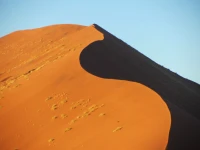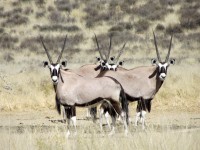If you go down to the woods today You’re sure of a big surprise. If you go down to the woods today You’d better go in disguise. For every bear that ever there was Will gather there for certain, because Today’s the day the teddy bears have their picnic.
That is the beginning of a song called “The Teddy Bear’s Picnic” which was a favourite of mine when I was a child. Of course, we don’t have any bears in Africa. But we do have plenty of other wildlife. Sometimes almost on our doorstep – even if we do not realize this.
Jos Badenhorst works for a local forestry company in the Southern Cape. He tells this interesting story of a “leopard cam” which they put up in one of the forests.
[I translated Jos’ story from Afrikaans into English. Any errors or misinterpretations are mine.]
Guest Post for Notes from Africa by Jos Badenhorst
My brother Christoff and I grew up in a forestry household and were exposed to the nature and the great outdoors from a young age. We didn’t have much of a choice. My father and mother loved nature and dragged us along to nature reserves, on hiking trails through indigenous forests, over the Drakensberg plateaus and along deserted beaches to catch bait fish and crayfish tails to lure a BIG Ignoblis (Kingfish). As a result of having the same interests, Christoff and I are close and with a good combination of “brains and brawn” we have over the years developed a certain way of approaching things.
Christoff (an engineer in Johannesburg) has a special affinity for leopards, and decided that he wanted to fund a camera for the Cape Leopard Trust (CLT). We did some research to find out what this entailed, and he bought the camera (Cuddeback motion sensor) and sent it to me. I made contact with Gareth Mann, who works as a CLT researcher in the area. He told me as it is our camera, we should place it at any location we think would be suitable.
Naturally, the idea at the start was to capture leopards on film, but because of the rich species diversity in the area – a result of a mixture of plantation, fynbos (natural shrubland or heathland vegetation) and indigenous forest habitats – we quickly realized that we would have a lot of fun seeing what other mammals would trigger the camera. I first tested the camera at the edge of a nearby patch of indigenous forest and captured several different species on film, including bushpigs, bushbuck, porcupines and many baboons. The camera was in that location for about two months. Then I found photos of my dog Maximus (a Weimeraner) and two other dogs Milo and Kodi (a Dalmation and Weimeraner belonging to another forester) on the camera. Obviously the camera was too close to the houses at the forestry station and we decided to move the camera to a different location. A spot in a remote section of the indigenous forest where people seldom wander.

Some bushpigs foraging in the forest. (Image supplied by Jos Badenhorst)

A bushpig poses for the camera! (Image supplied by Jos Badenhorst)

A male bushbuck. (Image supplied by Jos Badenhorst)

A porcupine tiptoes past. (Image supplied by Jos Badenhorst)
The feedback from the camera was impressive. Besides the daily visit of a baboon troop, who regularly “inspected” the camera, a pregnant looking female bushbuck and a couple of male bushbuck wandered past daily. We monitored the female bushbuck over the period of a month waiting for the little “Bambi” to make his or her appearance. Not long after that a baby buck appeared with its mother. What was interesting was the distinctive dots on the little one’s coat, which enabled us to figure out which bushbuck ram was its daddy.

A baboon passes by during the day . . . (Image supplied by Jos Badenhorst)

And another baboon does camera inspection! (Image supplied by Jos Badenhorst)

A pregnant looking female Bushbuck. (Image supplied by Jos Badenhorst)

First sighting of Bambi. (Image supplied by Jos Badenhorst)

Second sighting of Bambi. (Image supplied by Jos Badenhorst)
It was also surprising to see that there are still honey badgers in the area, as there few records of them in the Outeniqua mountains in the last 20 years. Again there were photos of the porcupine and the bushpigs at this location.
I did some research about leopards in the area. Gareth Mann did not know of any leopards in the area. If you talk to the local workers the last they heard of a “tier” (which means “tiger” in English – although we don’t have real tigers in Africa), was from campfire stories told about the “pest” which was caught some 50 years ago in the mountains by a local farmer. And nobody knew what he had done with the “tier”.
On the 29 August I went to download the latest images from the camera. I usually put the memory card in my own digital camera to check if the camera settings are correct before putting a new memory card into the “leopard cam”. Out of curiosity I quickly looked through all the photos to see what the camera had captured. After a few baboon and bushbuck photos (the usual suspects), I was delighted to see a photo of a leopard. We had hoped for one, but knew it was unlikely. There is 700km² of forest where a leopard can hide – and one just happens to walk past our camera! Now we know that the “tiger” still lives in our forests. All they need is a 100-600km² area where they can shelter, together with a healthy species diversity so they can get enough food, and then they have no reason to make their presence known to humans.

Xolo, the leopard. (Image supplied by Jos Badenhorst)
Interestingly enough, the baboon troop disappeared after the leopard came by and only reappeared three weeks later. As they do get hunted by leopards, they obviously didn’t want to be anywhere close to it.
Xolo (derived from the word “uxolo” of the Zulu language, meaning calm, peace and quiet) the leopard, has not come to visit again, but the camera is always ready for action!


















Loved this post Lisa! I hope we get to see more images from the camera.
Yes, isn’t it great?! Jos has promised to send me anything interesting they capture with the camera.
WOW! You really need a *LOVE THIS POST* icon, Lisa!
Thank you so much for sharing these photos with us, Jos. Amazing stuff – and it is so nice to know that there is still wildlife living in these forests. Well done on getting the shot of the leopard.
Thanks Reggie! We often go walking in the plantation/forest close to us. I’ve often wondered what animals pass along the same tracks. To think that such a variety of animals wander wild on these mountains is very encouraging.
Amazing how many different species travel that same path. It’s rather poetic.
I loved getting this “behind the scenes” view. That porcupine was impressive.
I was so happy when Jos agreed to share the photos and story with me. Although I’d only asked him for the facts, he wrote it so beautifully, that I ended up just translating it as is.
We even have porcupines were we live (our neighbourhood borders on farmland). Rosie and I were walking on the weekend, and saw one sheltering in a storm water drain.
What a fun post, Lisa. The little Bambi was certainly cute. Truly, a fascinating look at nature in your part of the world. Thanks to Jos for sharing!
Kathy
It must have been nice for Jos to see the Bambi story develop. I hope Jos becomes a regular contributor to my blog!
Love this post, Lisa. Xolo making an appearance a The Teddy Bear’s Picnic would certainly count as a big surprise. x
Thank you. Yes, I think it would be a huge shock to meet Xolo face-to-face. Thanks for reading the post and leaving a comment! 🙂
Lovely post. Hope there will be some more photos soon.
Thank you – I hope so too!
How fantastic is this!!?? Great quality photos and Xolo is beautiful…. B E A U T I F U L, I say!!
Johan used to live in a camp in Tanzania (a few years ago now) which had a visiting leopard. It would appear on the same rock, overlooking the camp, about every 6-8 weeks – and would never be seen in-between. It was as though he was “on patrol”… perhaps Xolo will visit this trail again before the end of this month? I’d be interested to know if he does!
Xolo is beautiful, isn’t he?! He also looks to be in very good condition. I also hope that they will see Xolo on a regular basis.
Thanks for all the positive feedback, and thanks to Lisa for making it possible. It’s nice to share the photo’s with people that appreciate it. Regards. Jos
Jos, I loved your story too. If you ever want to contribute to my blog again – you can see the topics I cover here http://wp.me/PYuZP-bj – you are very welcome to.
Jos and Christoff, a wonderful endeavour of yours. You make us proud. Dad and Mom
Thanks for coming to read the post and for leaving a comment! As you can see by the feedback on this post, Jos’ story has impressed and touched people.
Amazing pics!
Yes, the variety and quality of the photos they’ve got with the camera has been amazing. Thanks for leaving a comment! 🙂
After getting up at 4am this week and having the priviledge of seeing a female tiger in the wilds of Northern India, I know just how lucky it is to see any of the big cats. Love the pics and the concept of leaving a camera to see what passes… makes for a very interesting read! 😉
Wow, it must be really special to see a tiger in the wild! Just their size must be so impressive. How close were you?
The trip cameras have been used in a number of studies locally. Most of the animals in our forests are either nocturnal and/or avoid contact with humans. So it’s a great way to get to know what is wandering around here.
Thanks for visiting my blog and leaving a comment! 🙂 Just had a look at your site – you’ve got lots of great info there. Have subscribed to your podcast.
Wonderful! Rosie Bear, take care in those woods … Never get close to those porcupine and their sassy sharp spines! How fantastic to have had leopard sighting. Your human, Lisa may be interested in the Mammalmap project – a joint undertaking through UCT an Pretoria universities? Using trap cameras they’re trying to record what mammals still exist.
I never go walking in the woods at night, but Lisa and I did see a porcupine when we were walking around our neighbourhood early one morning. We were walking on the edge of our neighbourhood which is next to a farm. It was in a storm-water drain. Lisa didn’t see it at first, but I smelt it and jumped far away from the drain and started to bark.
Thanks for the Mammalmap info. Back when I was in research, there were a couple of similar projects here in the Southern Cape. Nice to see that there is a more co-ordinated project on the go.